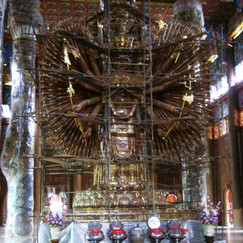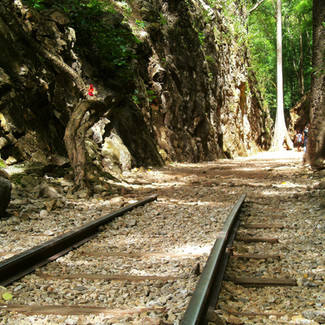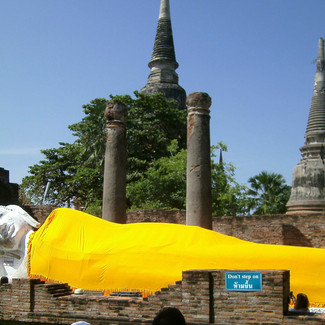Tom and Rebecca Hitch a Ride in the WABAC Machine

We thought about taking a day trip to Kanchanaburi, Thailand from Bangkok to see the bridge over the river Kwai. *Aside* I had no idea this was in Thailand. I guess I didn’t pay attention in school. Maybe it’s just that it was soooooooo long ago? When we checked on prices, the trip we wanted would cost about 3,500 Baht per person (about $100

each). When Vietnam was pulled from the itinerary we gained two weeks of time to fill, so we checked what a couple of nights in Kanchanaburi would cost. We found a little boutique

hotel called the P. Y. Guest House in Kanchanaburi for 1200 baht for two nights (breakfast an additional 125 baht each) or about $41.50. With an additional 2000 baht (about $58.00) for transportation and food we could spend two days. It was the perfect decision! We traveled to Kanchanaburi on the “Death Railway Train,” so named for

the Allied Prisoners of War who died digging out the pass to lay the tracks. The tracks originally went all the way to Burma but at the end of the war the connection beyond NamTok was removed. Upon arrival in Kanchanaburi our host from P.Y. Guest house gives us a thorough orientation. He helps us plan our trip to the Hellfire Pass Memorial the next day then took us on a whirl-wind tour of some of the other area highlights. *Aside* Our hosts at P.Y. Guest House were amazing. They repeatedly delivered us to the bus station and provided us with all the information we needed to make our visit to Kanchanaburi awesome!
On our first stop we visited the Kanchanaburi War Cemetary commemorating those who died during the building of the Death Railway. You won't find American graves here though. They were all sent home to be buried in the United States.
Next we saw a huge Monkey Pod Tree that our guide tells us is about 100 years old. These trees can grow up to five feet per year. *Aside* There is a fresh market near the Monkey Pod tree with a large vegetable that looks kind of like a watermelon (but isn’t). Via translator we figure out that it is a gourd. I was dumfounded. I’ve seen seeds for ornamental gourds all my life, but in Asia there are about 400 varieties of edible gourds. Who knew?
Next we visit the Tham Puh Wu Temple then on to the Khoa Pun Cave Temple.
Our host takes us to a new Hindu temple which has been under construction for the last ten years. The details of the pillars are still under plastic covers to protect them until opening day sometime this year. *Aside* I bet there will be a fabulous festival opening! We stop for some lunch here. Every day the temple serves free lunch for anyone who stops by. This probably feeds the people who are working on the temple as well.
Next is Wat Tham Khao Noi. This is an enclave of numerous temples and pagodas in completely different styles. The view from the top of the hill is amazing!
Finally we visit the Wat Ban Tham Golden Dragon Temple. *Aside* This was probably my favorite. I really wanted to walk up into the mouth of the dragon, but my knee said I’d done enough walking and climbing for one day, especially if I planned to walk Hellfire Pass tomorrow.
Next morning we go by van to the Hellfire Pass Memorial, created by Tom Morris, a former POW who was forced to work on the railway, and maintained by the Australian Government. They provide audio headphones with vivid descriptions of everything for free. During World War 2, the Japanese forced Allied prisoners of war to build a railway from Thailand to Burma so they could supply their army when sending supplies by sea became too dangerous. Pierre Boulle wrote the original book, Bridge Over the River Kwai which was made famous by the 1957 film The Bridge on the River Kwai. *Aside* The book was based on the fact, but the river the bridge crosses was not actually the Kwai, but the Mae Khlong. When throngs of tourists started showing up to see it, the Thai Government renamed the river, Kwai Yai (Big Kwae) to make it less confusing for the (obviously) already confused tourists. It is estimated that more than 12,000 of the 60,000 POWs who worked on the railway died. In addition, 70,000 to 90,000 civilian laborers died as well. The workers were forced to dig out the walls of rock by hand using the most primitive tools. They also built bridges from the timber cut from the surrounding jungle. There was virtually no medicine for sick or injured workers. When their clothing and shoes rotted off their bodies, there were no replacements. There were no blankets and they lived on two servings of rice a day. They were beaten mercilessly. When the order came from Japanese Headquarters to finish the railroad four months early, every man worked sixteen to eighteen hours a day rain or shine around the clock, carrying baskets of rocks and debris away from the rail bed on their backs. *Aside* I can’t begin to describe the suffering of the men who built this railroad. If you’re interested read some more of the history about what is reduced to a line in a text book. Walking the quiet, peaceful pass today belies the misery and suffering of those who built the railway. The emaciated workers dubbed the Konyu Cutting the Hellfire Pass: certainly it looked like hell in the flickering bonfire light while they worked through the night.
We leave the Memorial, catching a bus to Nam Tok and then the Death Railway Train back to Kanchanaburi. On the train we were thrilled to see the sheer cliffs on one side and the drop into the valley below on the other. Our train traversed the Wampo Viaduct which is still a wooden trestle, then crossed the bridge over the River Kwai (or Kwae if you’re from Thailand).
*Aside* This was truly an instance where history came alive for Tom and me. Tom is more a history buff than I am, but I am grateful that we went on our own so we could walk the pass with its deeply emotional ties to the past. We were there for about three hours. If we had gone with a tour we would have had one hour at the most with no time to walk to Hellfire Pass.
Next something more ancient: Ayutthaya, the second capital of the Siamese Kingdom, founded in 1350. Ayutthaya flourished from the 14th to the 18th centuries. During that time it grew to be one of the world’s largest and most cosmopolitan urban areas and a center of global diplomacy and commerce. Ayutthaya was strategically located on an island surrounded by three rivers connecting the city to the sea. The city was attacked and razed by the Burmese army in 1767 burning the city to the ground and forcing the inhabitants to abandon the city. The city was never rebuilt in the same location and remains known today as an extensive UNESCO archaeological site. Our new hotel is Baan Baimai Boutique, slightly more expensive than P.Y. Guest House at about $60.00 for two nights. Our host books a tuk-tuk for us (about $12.00) to do a night tour of the ruins. This provides some dramatic pictures. Next day we book another tuk-tuk for the day (about $27) to tour the various archeological sites. The structures are amazing. We sit in the shade for a bit trying to imagine what it might have been like to live in this city at its height. *Aside* I would have enjoyed going to the Institute of Ayutthaya Studies to better understand what life was like in this city. I just don’t understand the culture well enough to imagine myself in it.
First we visit Wat Yai Chai Mongkol built by King U-thong in 1357 A.D. for the use of the monks who had returned from Ceylon after studying under Phra Vanarat Maha Thera. *Aside* We were delighted to discover that most of the entrance fees to these sites were waived in honor of the King’s death.
Next Wat Maha That or the Monastery of the Great Relic that houses Buddha’s relics. The temple was

destroyed by the Burmese who also vandalized many of the Buddha images in Ayutthaya by lopping off the heads. This is also the site of the iconic image of Buddha’s head in the tree roots. *Aside* I know I’ve seen this picture in books. Never dreamed I’d see it in person!
Wat Para Si Sanphet was the site of a royal monastery and palace. There was a 16 meter high statue of Buddha coated with 143 grams of gold that was melted off by the Burmese.
Wat Lokaya Sutharam is a reclining Buddha on the restored ruins of a monastery.

*Aside* As we tour the city we see people riding elephants. I understand that this has historic
precedence, but it is now known that forcing an elephant to walk on hard, hot pavement for hours on end carrying people on a rack on its back is very painful and debilitating for the elephant. It looks like fun, but we didn’t do it!
Wat Chaiwatthanaram is one of Ayutthaya’s best known Buddhist temples. King Prasat Thong ordered the temple built to honor his mother, featuring the architectural style influenced by Angkor temple in Cambodia—its unique feature is a large, central prang (Khmer-style pagoda) surrounded by smaller prangs, symbolizing Mount Sumeru, the gods' mountain according to Hindu belief. Our history lesson complete, we return to Baan Baimai. They have a small restaurant on the premises so we chose the easy way to dinner, ordering some chicken fried rice. I’ve stopped eating fried rice in America because it is either too oily or virtually tasteless, but this was delicious. I’ve been missing out in Thailand!! In the end we toured two cities in a four day adventure for only slightly more than the price of a one day excursion. We were able to leisurely spend as much time as we desired at each location without completely exhausting ourselves with rush-rush. Ah! This is what makes this trip great!














































































































































